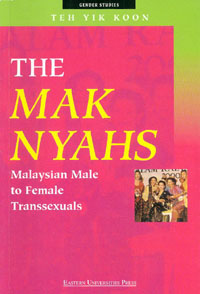-
This book draws attention to the plight of male-to-female transsexuals, or mak nyah, in Malaysia. Teh Yik Koon draws on both quantitative and qualitative research, including surveys, questionnaires and interviews, to bring to the reader's attention issues affecting mak nyah, including why individuals identify as mak nyah; societal responses to mak nyah; government policies affecting mak nyah; police attitudes toward mak nyah; knowledge of mak nyah regarding HIV/AIDS; support networks available to mak nyah; and mak nyah thoughts on, and access to, sex-reassignment surgery.
-
The book is divided into ten chapters. After the introduction, which presents an account of the author's initial forays into the world of mak nyah, the history and definition of transsexuality is discussed. The book details the progression of Western discourses on transsexualism. Looking at the work of Anne Bolin, Richard Ekins, Janice Raymond, and others, Teh examines the ways in which transsexualism have been viewed. She concludes that the term transsexual (as opposed to transvestite or transgender) is the preferred term used by the transsexual community in Malaysia because, 'the ultimate goal or wish of the majority of them is sex reassignment surgery' (p.17).
-
A review of research conducted on transsexuality in countries outside Malaysia is included in the book. The studies which Teh evaluates are primarily grounded in psychological spheres. While understandable in the sense that there is an expanse of clinical research on transsexualism, a more socio-culturally-centred analysis might have better illuminated the aims of Teh's book. Because of the particular literature reviewed, there is arguably an over-reliance on quantitative data vis-é-vis qualitative information. There are some case studies drawn from ethnographic material, such as Nanda's (1990) work on hijra in India, and Spiro's (1967) work on nats in Burma, and a more in-depth comparison might have been a valuable exercise as conceptualisations of transgenderism/transsexualism in these regions could have provided a useful framework through which to explore mak nyah subjectivity.
-
An analysis of research conducted in Malaysia is also undertaken. There is an informative discussion on Islam, which reveals that in Malaysian interpretations of Islam gendered individuals can be divided into four groups: male, female, khunsa [hermaphrodites], and mukhannis [males whose behaviour is closely aligned to women's behaviour] or mukhannas [an effeminate male who does not want to change his sex] (p. 45-47). Islam in Malaysia permits khunsa to undergo sex reassignment surgery so that they can become either male or female. However, mukhannis or mukhannas are forbidden from undergoing sex-reassignment surgery. In 1983, a fatwa prohibiting sex-reassignment surgery was imposed on all Muslims in Malaysia. Cross-dressing was also forbidden. As most mak nyahs are Muslim, they have become non-entities in Malaysian society (p. 46).
-
The book provides statistical information on mak nyah, including facts about religious adherence, upbringing, income levels, and ethnicity. An exploration of what it means to identify as mak nyah is addressed. Discussion of what the concept of gender means in Malaysia would have been a useful inclusion. For instance, mak nyah is defined as 'men who are like women', or 'men who dress up as women' (p. 55), but this leaves the reader wondering what it means to be 'like a woman' in Malaysian society.
-
Teh concludes by arguing that mak nyah are heavily influenced by their religion (predominately Islam). This adherence strongly shapes their identity. As a result, not all mak nyah are willing to undergo sex-reassignment surgery because it is considered a sin under Islam. Teh concludes that mak nyah 'consider themselves transsexuals who have accepted that they have a female heart, but who may not go for the sex reassignment surgery and do not mind the presence of their penis' (p. 108). As such, Teh argues that mak nyah basically share the same characteristics as transsexuals in other parts of the world (p.102).
-
The final chapter reproduces interviews Teh conducted with key religious figures, authoritative figures (e.g. police), medical doctors, and mak nyah themselves. This information might have been better spread throughout the book in order to give richness to mak nyah subjectivity which quantities data does not reveal.
-
One of the most important contributions this book makes is in alerting readers to issues of HIV/AIDS awareness. It presents valuable insights into perceptions of HIV/AIDS among mak nyah, and examines issues surrounding condom usage by mak nyah and their partners (p. 79). The book reveals that there has been an increase in knowledge about HIV/AIDS. A 1992 study by Donna Rae Palmer revealed that while 93 per cent of mak nyahs interviewed (27 respondents) had heard of HIV/AIDS, 30 per cent believed that it could not be transmitted by oral sex and 56 per cent believed HIV/AIDS was only transmitted through sex with foreign men (p. 79). In Teh's study, 98 per cent of mak nyah had heard of AIDS; 91 per cent knew HIV/AIDS could be transmitted through anal or vaginal sex; and only 20 per cent thought that foreign men exclusively transmitted HIV/AIDS. The book also reveals statistical information about condom usage. It shows that 90 per cent of mak nyah would use condoms if they were easily available (p. 82), and that income level affects condom awareness and the practice of safe sex (p. 85). HIV/AIDS did not appear to be a primary concern for many mak nyah participants.
-
While this book would have benefited from including more in-depth information on notions of mak nyah subjectivity, it makes a useful contribution to knowledge on issues of sexuality in the Malay world. Moreover, the royalties of this book go towards assisting mak nyah participate in Malay society through fostering the right of individuals to live as mak nyah.

|

